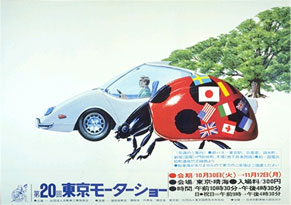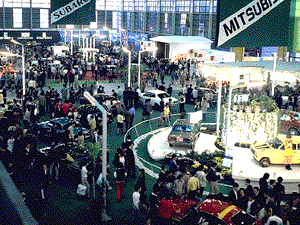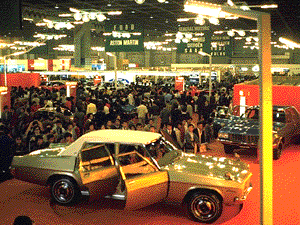 |
 |
 |
The
20th Tokyo Motor Show (1973
. 10/30 - 11/12)
 |
 |
| The 20th Tokyo Motor Show Poster |
The year 1973 was the 20th anniversary of the Tokyo Motor
Show. JMIF, in celebration, presented two special displays
on "Development of Vehicles" and "Man and Automobiles."
The former was an easy explanation of how vehicles progressed,
and the latter endeavoured to review the role of automobiles
in society. This was also discussed in the guidebook.
JMIF s scheme was appropriate for the celebration, contributing
much to the success of the show.
The "Development of Vehicles" display consisted of actual
cars, model cars, and photographs. The actual cars were
the Datsun Car No.1, other pre-1955 Japanese models and
foreign classic cars numbering 29, and 17 custom cars
which charmed old car enthusiasts. The other theme, "Man
and Automobiles," was also emphasized with the display
of leisure cars anticipating future uses of cars, and
the display of a new traffic system.
Regarding safety measures, prototypes from various countries
were introduced at an Experimental Safety Vehicle (ESV)
international conference held in Kyoto in the spring of
that year. At that conference Japanese ESVs were the target
of keen interest from engineers from other countries.
It was impressive that those ESVs were displayed at the
Motor Show, and demonstrated high Japanese technological
safety standards, attracting foreign visitors attention.
|
 |
 |
 |
New cars, the greatest attraction of the show, included Toyota Starlet, 1200cc mass-market car, and a few others. The rest of the exhibits were dressed-up versions of familiar cars. What was popular at the show was JAF s repair workshop. The lack of new cars reinforced the trend of the past several years away from the traditional practice of launching at the show. Intensified competition among automakers caused them to try to announce their new models earlier than their rivals, and the need to respond quickly to safety and environmental concerns also encouraged this. Meanwhile foreign car booths became livelier. Foreign vehicles exhibited at this show were 62 passenger cars by 20 companies from 7 countries, and 5 motorcycles. The parts section included participation by the Canadian government. It was a characteristic of this show that the wave of internationalization reached the parts pavilion. The popularity of foreign cars was shown in the fact that 74% of show-goers visited the foreign car booths.
During this show, discussion centered on the oil crisis attacking the auto industry. It was so serious that the industry decided not to hold a motor show in the following year.
|
 |
|
|
|